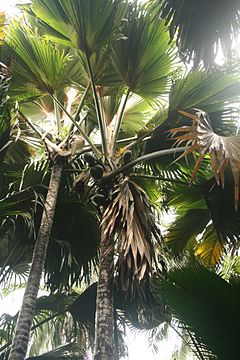| Habit | palm-cycad
| |
|---|---|---|
| Lifespan: | ⌛ | perennial |
|
Lodoicea > |
Coco de Mer has the largest seeds (up to 17.6 kg) and fruits (up to 42 kg) of any plant in the world. The seeds are notable for resembling human female buttocks.
Read about Lodoicea maldivica in the Standard Cyclopedia of Horticulture
|
|---|
|
Lodoicea maldivica, Pers. (Cocos maldivica, Gmel. Borassus Sonnerati, Giseke. Lodoicea callipyge, Comm. L. sechellarum, Labill.). Fig. 2192. Tall dioecious palm, large in all its parts: lvs. palmately not deeply cut into many flabellate lobes or segms., the blade 6 ft. across, oyate-subrhomboid, cuneate at base, the segms. bifid, petiole 8-10 ft. long: fls. in axillary spadices which are subtended by several truncate spathes, the male fls. in clusters in the hollows of the axis of the spadix and the female fewer and in cups or receptacles formed by a pair of bractlets; stamens in male fls. about 36, the pistil rudimentary; ovary in female fls. mostly 3-celled, the stamens being represented by staminodia: the great fr. usually 1-seeded, mostly 2-lobed: male spadix to 6 ft. long; female spadix of similar length, pendulous on a peduncle 1 ft. long; perianth ½ in. long. The double coconut is one of the giants among palms, its straight and smooth trunk frequently reaching a height of 100 feet, and it is also a centenarian before its full growth is attained. The seeds of lodoicea are probably the largest known, the individual nuts being said to weigh sometimes fifty pounds, though the largest usually seen in collections do not likely exceed about fifteen pounds. The formation of such gigantic seeds requires a considerable period of time, and from the time of flowering to the full maturity of the seeds is said to cover a period of nearly ten years. The germination of such seeds is not an easy process, requiring much room and strong heat, the radicle being correspondingly large and running down for 3 feet or more before the top growth begins. Young plants require a strong and moist heat; and a considerable amount of root room, in combination with a light but rich compost, is best adapted to their needs. Seeds sometimes require three years to germinate. They are not advertised for sale at present, but have been sold as curiosities now and then in America. Their germination is a great event, but the plants are never grown to any considerable height, as they require too much care and room. The old nut remains attached at the surface of the ground until the tree is some years old. It is said that the heart of the crown of lvs. is eaten, as in the cabbage palm, and the lvs. are used in house building.
|
Cultivation
Propagation
Pests and diseases
Species
Gallery
If you have a photo of this plant, please upload it! Plus, there may be other photos available for you to add.
References
- Standard Cyclopedia of Horticulture, by L. H. Bailey, MacMillan Co., 1963
External links
- w:Lodoicea maldivica. Some of the material on this page may be from Wikipedia, under the Creative Commons license.
- Lodoicea maldivica QR Code (Size 50, 100, 200, 500)
